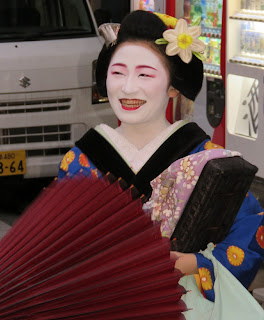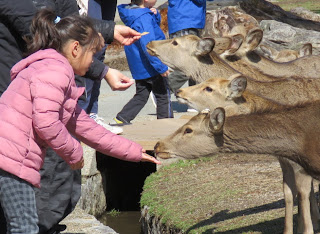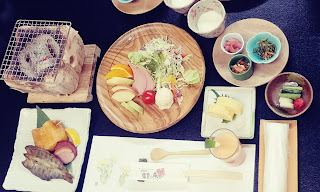 |
This is not on sale... a $100 cantelope
Perfectly grown fruit is given as special gifts in Japan |
Before we move on, we have to back up a little because we forgot to tell you about our "fire sale" dinner. We had written about the large grocery stores located in the bottom of the department stores at train stations and the choices are quite overwhelming. The stores close at 8PM so at 7:30 or so all of the pre-made items are put on sale (often at 1/2 price) because they will not resell the following day. So for dinner in Kyoto we experienced the "end of the day fire sale". We got a great beef bento (lunch) box, meatballs, sweet and sour chicken and steamed buns all for about $20.
The following night after visiting Nara, we found a yakitori (stuff grilled on a small wooden skewers) restaurant just around the corner from our hotel. It was a real hole in the wall type place with maybe 15 seats total around a small bar/kitchen. Initially we were the only customers but the two workers welcomed us in and even provided us with an English menu. There were a few set dinner menu combinations and a couple of "let the chef pick", but in general you just order items by the "stick". There were some odd items like chicken feet, beef tongue, lots of intestinal parts, so letting the chef pick might be a little risky. So we started ordering items, one by one to sample all kinds of grilled and deep-fried meats. It was a great experience and great food! This place must have a regular customer base because there was one price listed on the menu for walk-ins and a slightly lower price for members.
March 19 - Hiroshima
 |
| A-Bomb Dome |
Even taking the bullet train from Kyoto to Hiroshima, it was a two hour journey, mostly in tunnels or troughs so not much to see. Hiroshima is, of course, known for the first atomic bomb used in war, so the must see places include the A-bomb Dome and the Peace Park. The A-bomb Dome is portion of a public building that was near ground zero which withstood the blast. The covering of the dome of the building was blown away, but the steel structure of the dome and most of the building remained.
We found another small Korean-style barbecue (small charcoal grill at your table) for dinner and enjoyed grilling our own meat and vegetables on the table top grill. Again, the staff was great providing an English menu and helped with ordering. Ted has noticed that finding limited English speakers is more common than his previous trips. English is taught in the middle and high schools, so most young people speak at least limited English and feel comfortable talking with us. Also, the widespread use of the internet has probably helped as well. Just like in the states, everybody is glued to their phone on the sub-way, train or bus.
March 20 - Cycling the Shimanami Way
 |
| Beth modeling her $5 rain coat |
After breakfast we arranged for our luggage to be transferred to Osaka where we will be staying on the 21st. Then with our backpacks loaded for one night, we took two local trains to arrive at Onomichi, the beginning of our cycling route. We'd been watching the weather all week and the rain prediction was correct. The morning started with spitting rain which continued all day increasing in intensity from around 1PM on. Although we had brought raincoats with us, we found out early on the trip that they weren't very water-resistant any more. So we spent some time in Hiroshima looking for cheap raincoats. At the ever ready convenience store (FamilyMart) we found 500 yen ($5) clear plastic raincoats and they really saved the day. And yes, we found one that fit Ted,,the sleeves were a little short, but it sure beat nothing and did the job.
The cycle ride started with renting bikes in Onomichi and then a very short ferry ride to cross over to the next island. About 4 miles into the ride, Ted had a flat. The rental bikes had no spare tube or pump. We saw several more cyclist, but none with a pump. We
 |
Bike "selfie" climbing up to one of the
bridges... had to keep thinking...
"ride on the left!"... just like the UK |
were a long way from any bike terminal, but were fortunate enough to have a friendly Japanese bike rider, with a reasonable amount of English, stop and use his phone to call the emergency number. After a lengthy conversation in Japanese, describing the problem and our location, he ended the conversation and indicated it would be about 30 minutes but we would get a new bike. Ted's first bike was small for him and the next one was even smaller. He raised the seat to the maximum and was still probably 2 inches short of being tall enough, but he made it work.
 |
| One the early bridges we crossed |
In all, the ride is 50 miles linking multiple islands by 6 suspension bridges. Although the route is generally flat the climbs up to the bridges were not! Despite the rain, the views were spectacular and well worth the ride. It would be simply stunning in good weather and in better weather many of the small towns had temples and castles that would be fun to visit. The last bridge, the Kurushima Kaikyo, was 4 km long and has 6 towers, the longest suspension bridge structure in the world. By then it was raining harder, the wind was picking up and getting cold but we endeavored to persevere and made it all the way to the Imabari rail station to turn in our bikes.
Sadly, we walked into the nicest hotel in Imabari (4+ star) looking like dripping wet dogs covered with road grime. After dripping all over the check-in counter, we slogged our way to our room to shed our wet clothes and clean up. That night our bathroom was a sauna, what with trying to dry out all the wet clothes, our backpacks and shoes using the hotel hair dryer. As tired as we were neither of us wanted to go out to dinner (in the rain) so again the ever ready convenience store (Lawson's) a block from the hotel provided dinner.
 |
| The Kurushima Kaikyo bridge is 4k long and fades into the fog. The bike path spirals up from near sea level on both ends to get to the bridge. It is an engineering marvel. |





































